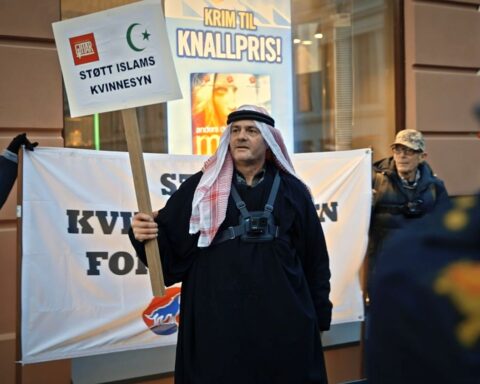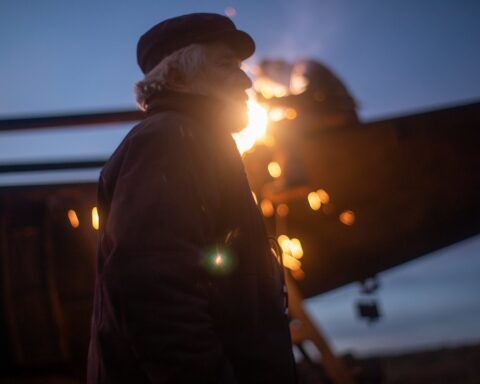Machines and Cold Valley are part of a cluster of films at Hot Docs that fall into the sub genres of labour and environmental investigation.
Cold Valley by the young German director duo Florian Fischer and Johannes Krell is a white cube documentary art installation, which actually started out in a heavily stylized, antiseptic gallery space. The camera zooms in on a framed image of lush green plants through shrinking white, empty wall space—until we notice the plants moving under raindrops. Then the film swallows us for the next 12 minutes into structured, textured, monochrome whiteness, carried by a monotone alternating rhythm of stasis and movement. The hypnotic effect certainly contributed to the film receiving the German Short Film Award in Gold when it came out last year.
This whitening out throughout the film is the result of lime extraction that coats the environment in what looks like powered sugar or artificial snow in a winter wonderland (for nature’s protection, to counter acid rain). Once, the process and its filmic documentation powerfully blow up in our faces in what turns out to be a violent rock explosion spewing debris at us. The directors gleefully present us with these picture puzzles. Miraculously, the visual trickery and aesthetic abstraction is artful and effective and strangely does not amount to mere eco porn; it’s more like an intriguing elegiac poem. The images do not move ahead a recognisable linear story or message about the space we are entering (unless you really know your strip mining and forest liming), but leave the viewer with a sense of alienation, of intervention. Silent man, as big as the maggots crawling over the chalk dust, only occasionally enters the scene to trigger a machine. You do get the feeling that this is not natural, not an enchanted forest but perhaps cursed wood or a Planet of the Apes-y slow-mo sci-fi landscape. You are left with the paradox of the anthropocene, between lure and unease.
Out of the “snowy” Cold Valley, we walk into the fiery flames of an Indian sweatshop in Machines, a film, which was in competition at Sundance earlier this year. A man is stoking an industrial furnace, only protected by a handkerchief. Here, the titular machines are of steel and flesh. Unsurprisingly, the labourers—the human machines—-are less well maintained by their bosses than the first. In some scenes, both nearly melt into each other, as when a worker puts his feet on a spinning metal kettle, his body shaken in a sort of full body massage. A Western viewer sees an ongoing health hazard and a workplace accident waiting to happen while an Indian sees work. Artful filmmaking and camera work literally walk or float us through the enclosed eco-system (the mill) in clever tracking and following shots. It is first-time filmmaker Rahul Jain’s masterly timing and dramaturgy that every time you are about to get lost in the initially isolated and cryptic steps of the industrial process and develop a burning question towards the film —what are the wages, what are the hours, where do they all come from—he knowingly steps in with an intervention or short interview or scene change. Jain uniquely puts the viewer at eye level with the workers (as much as that is possible), entangling and capturing them in the same limited scope of action and (false) hope, simulating the depressing and frustrating non-choices of these millions of migrant day labourers.
The Indian-German-Finnish co-production’s cinematographer Rodrigo Trejo Villanueva undoubtedly deserves his Sundance Award. Just when the glorious images, steeped in browns and reds and rusts, might overwhelm the film, Jain reigns it back in or breaks the rhythm or changes the mood for a moment. The filmmaking mirrors the noisy cacophony of the rolling dye drums, the mind-numbing repetition of each professional gesture, but most of all the relentlessness of the climate, work, and poverty. And thus it is a relentless film that is hard on the senses with its barrage of sights and sounds, a film that rarely gives a reprieve and feels longer than it is. My fight or flight instinct kicked in several times, for example when a boy just cannot physically keep his eyes open at work and nearly falls into his machine. The camera holds on to his face minutes past the point where I want to jump up and pull him out of the screen. As another young boy describes: “My gut feeling tells me every day at the factory gate to turn around but I can’t.”
“We’re not exploited,” one worker provocatively states, “no one forces us.” But he eloquently explains how they are indentured by circumstance, forced by poverty, enslaved by lack of alternatives. One authoritatively summarizes: “Poverty is harassment. There is no cure.” Jain touches upon the solutions: Unionisation? Leaders who organise get killed, a gutsy worker tells us, nervously looking over this shoulder. Strike? You’re fired. Government regulations? The unapologetically ruthless middle-class boss —whom the workers have never seen but who watches them around the clock on his factory floor surveillance screen— waves the idea off as ludicrous. Empathy? “The workers don’t care, the factory would have to close if I paid them more,” says the owner. “We help them out with five rupees here and there,” appeases the manager. Taking the employers to court? The often-illiterate workers cannot afford the journey to the city to exercise their merely theoretical legal rights. Further computerisation and automatisation? Having no job would be worse than having this job. Even if not enough to save and better yourself, it is the simple difference between a meal or none. Fairer profit sharing? The Indian fabric seller haggles over every dollar with Arab buyers, against other cheap Asian competition. No exit sign anywhere, not from the compound, not from the vicious circle of poverty. Death is the only equalizer between rich and poor, a worker tells us in line with the Hindu karmic tradition.
Undiluted, unadulterated capitalism, survival of the fittest taken to the extreme, it’s somewhere between the Roman circus and the UFC (Ultimate Fighting Championship) only it’s truly real. References to Northern England in the early 1800s come to mind, but this is probably still worse than any Dickens novel. When you think you have seen the bottom of the pit—small children with their bare hands emptying chemical waste over the factory fence into an open sewer—Jain (the descendant of a factory owner) keeps digging down, with the kids scavenging through the slush for recycables or scrap metal. If this was a Harun Farocki film, it would be “Workers Never Leaving the Factory”.
In Cold Valley we never emerge from the opening picture frame. At the end of Machines, Jain takes up on the rooftop of the mill, playfully dressing the labourers in the light, colourful gauze they produce, like in a joyful, liberating Holy celebration. It’s short-lived and deceptive, as the director then takes a sweeping aerial pan over the locale—of mill after mill after mill. In a country of 1.3 billion with 30% under the poverty line, we are turning in circles.
This is not the first in-your-face activist film, which will make the audience put on their T-shirts without the same ease the next morning. Corporations or consumers do not directly get taken to task. The heft and might and sensual assault of giving much more than a glimpse of the labourers’s plight and imprisonment has produced an astounding piece of documentary film-making by Indian CalArts alumnus Rahul Jain.








